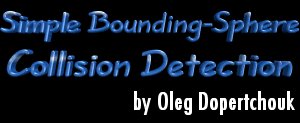11/10 - 11/12 @ Montréal, Canada
12/5 - 12/7 @ Shanghai, China
12/24 - 12/27
2/28 - 3/4 @ San Francisco, CA
More events...
2406 articles in the reference section.
Help us fight cancer!
Join SETI Team GDNet!

|
One more improvementThe code in snippet 2 works quite well in many circumstances but there's a little problem with it. It is not a mathematical problem but a computer-related one. Think about the very last calculation Say the distance between the objects is about 100 units and the objects themselves move about 100 units per frame (this is just an order-of-magnitude estimation, so the exact values are not important). Then pv, vv and pp are generally all about numbers around 100*100=10000. Then their products are about 10000*10000=100000000! And we subtract these values. What happens is a fantastic loss of precision amd the result of the computation can off by miles. What's worse the sign can turn out completely wrong as well, so we may flag non-existant collisions or even dismiss perfectly legitimate ones. Your bullets might fly right through your enemy's head and and his ones might hit even though you have ducked at the last moment. Not good. We need something to tame the numbers in our calculations. What you can do is to divide the formula above by vv, that will bring down the numbers to a more manageable size. Since by that time we know vv is greater than 0 (if it is 0 then so will be pv and our check 2 will fail) so the sign will be unaffected. We do have to spend more cycles on the division but it happens only if all other tests have failed. Here's the final version of the collision test that does calculate the time. Code Snippet 3 ConclusionSo here it is, the bounding-sphere collision detection algorithm. It might be useful as is (say, for a pool game) or can be a quick-and-dirty test before doing a more sophisticated check - polygon-level, for instance. You may also want to try to improve the accuracy of the collision detection by using a hierarchy of bounding spheres, breaking your object into several parts and enclosing each of them in a bounding sphere of its own. |
|||||||||||